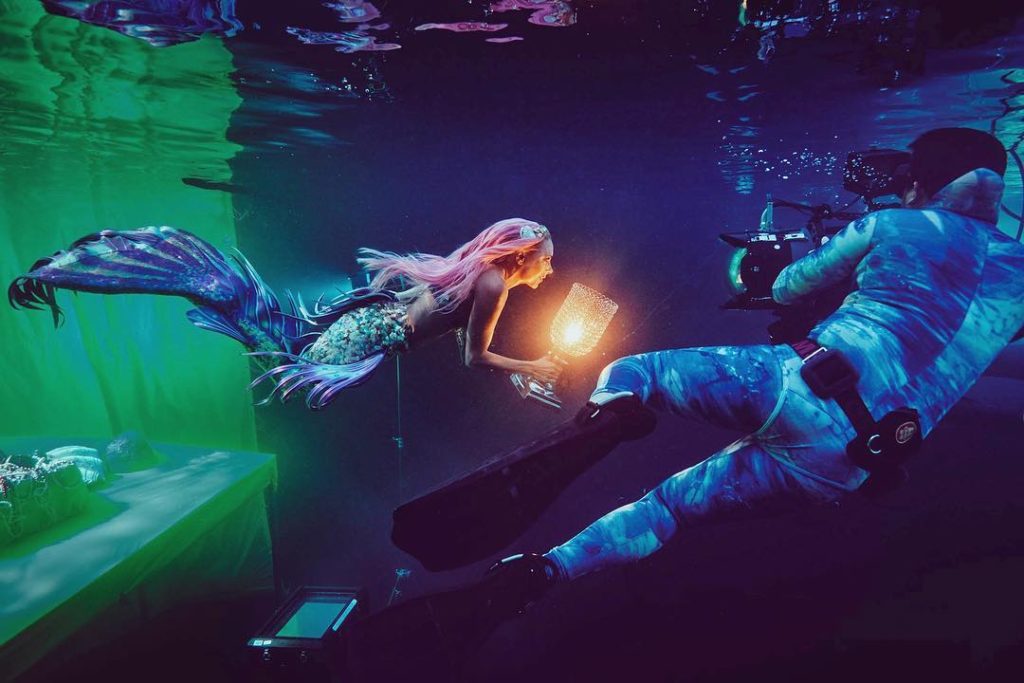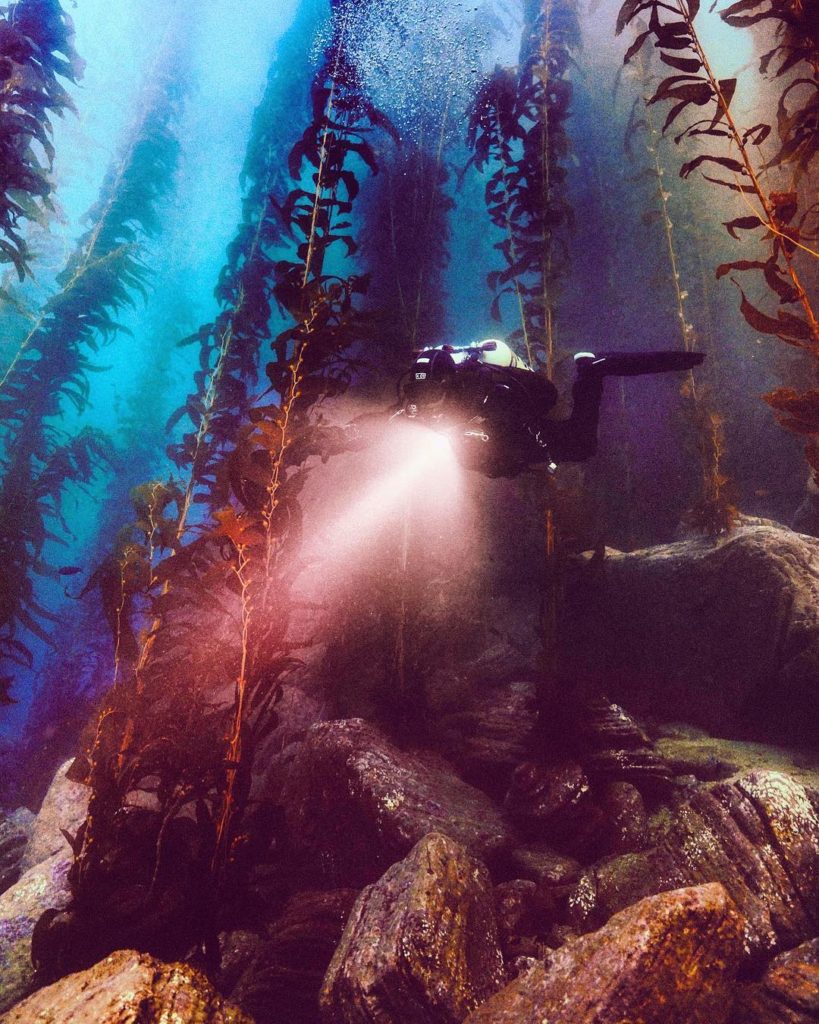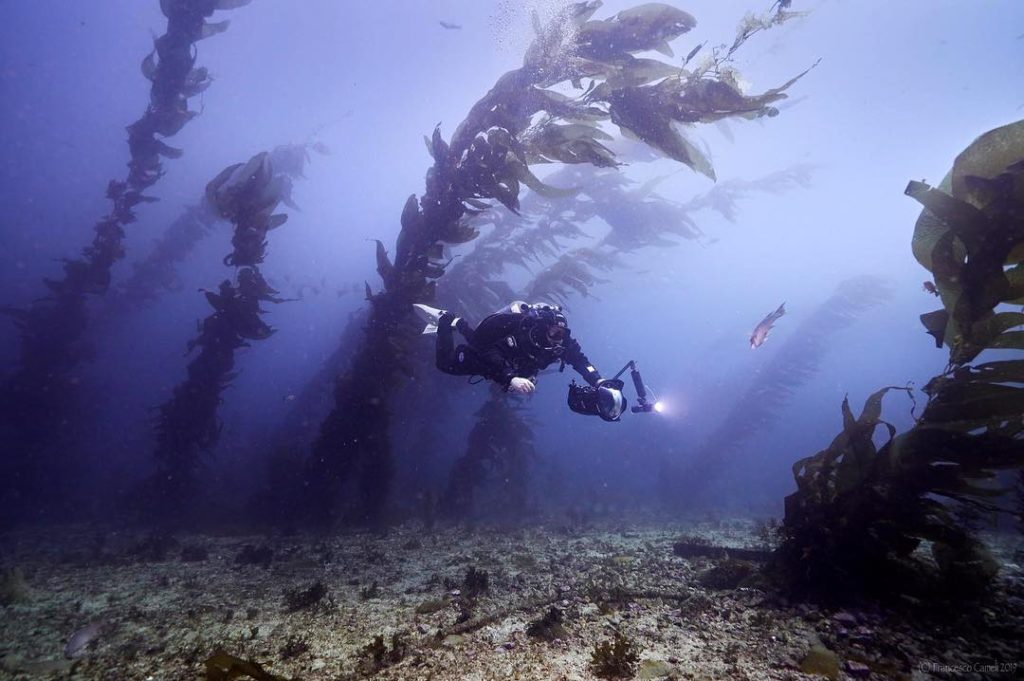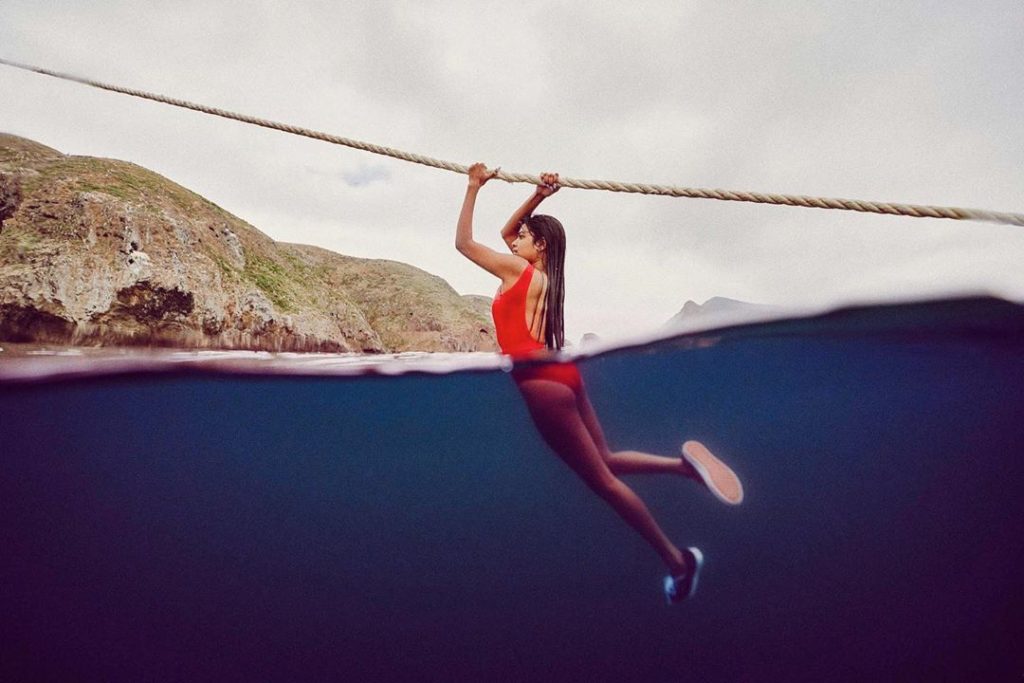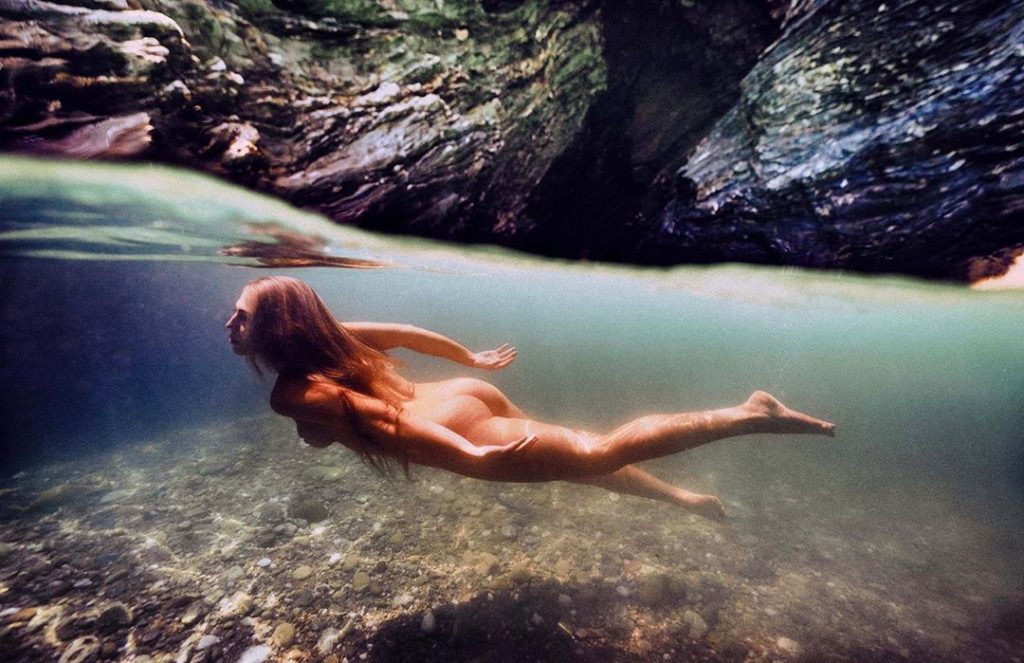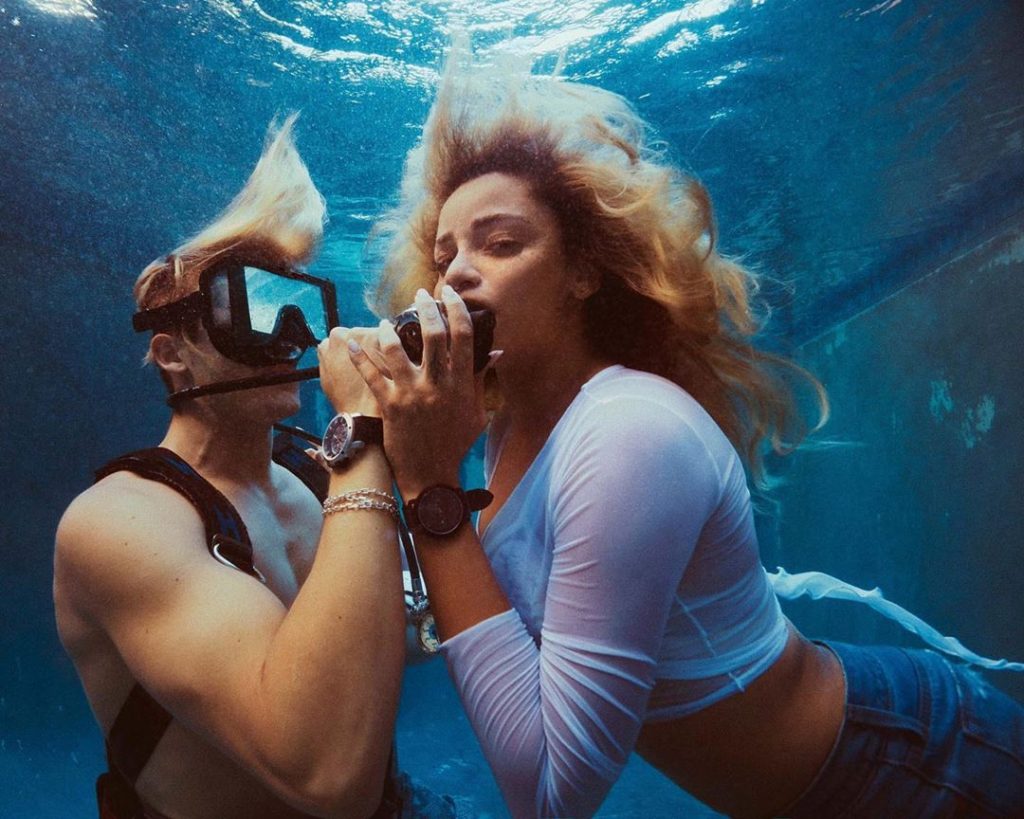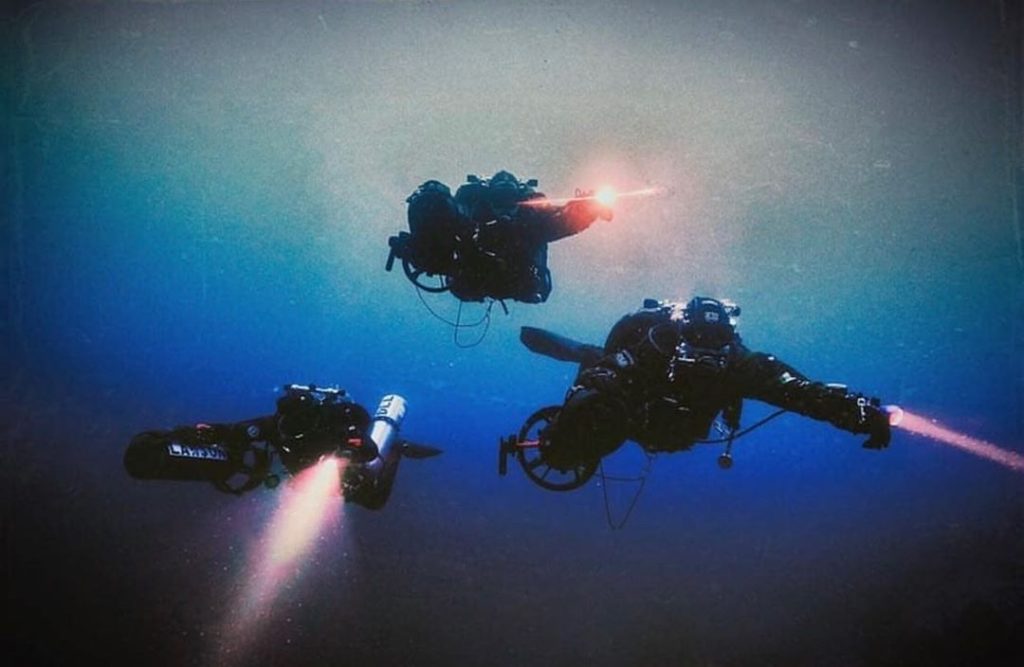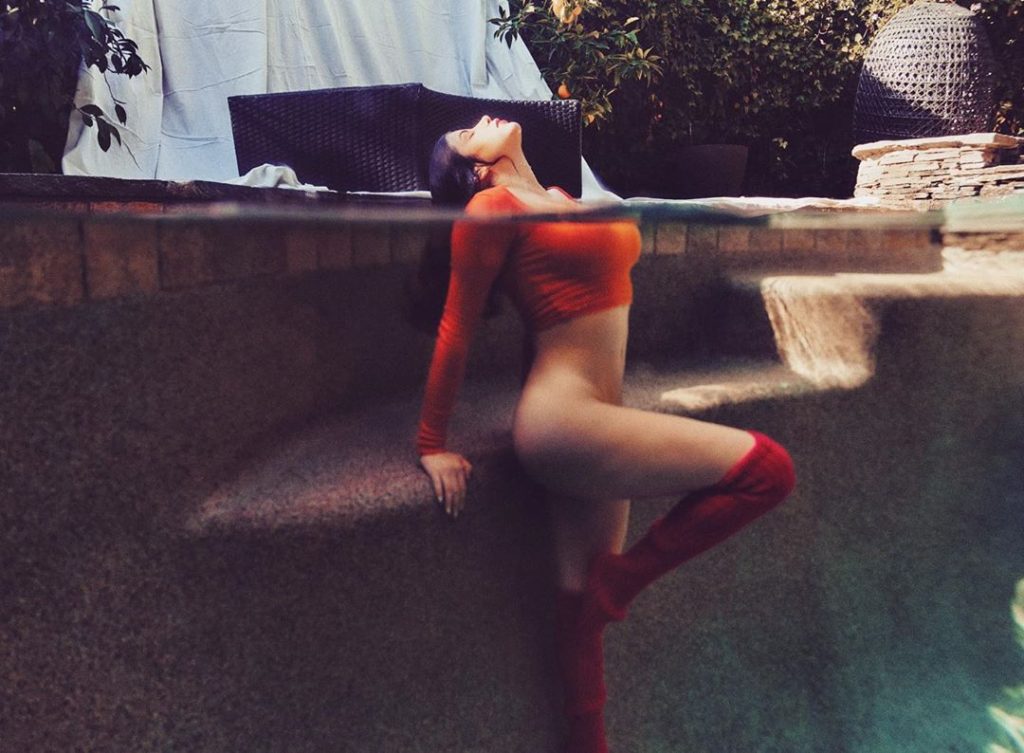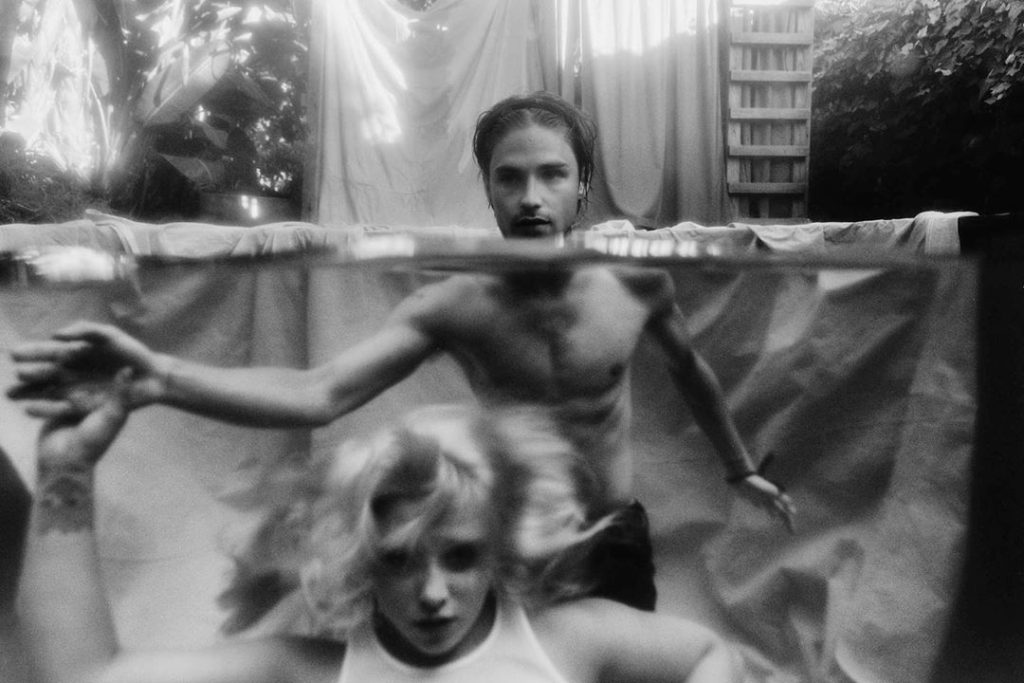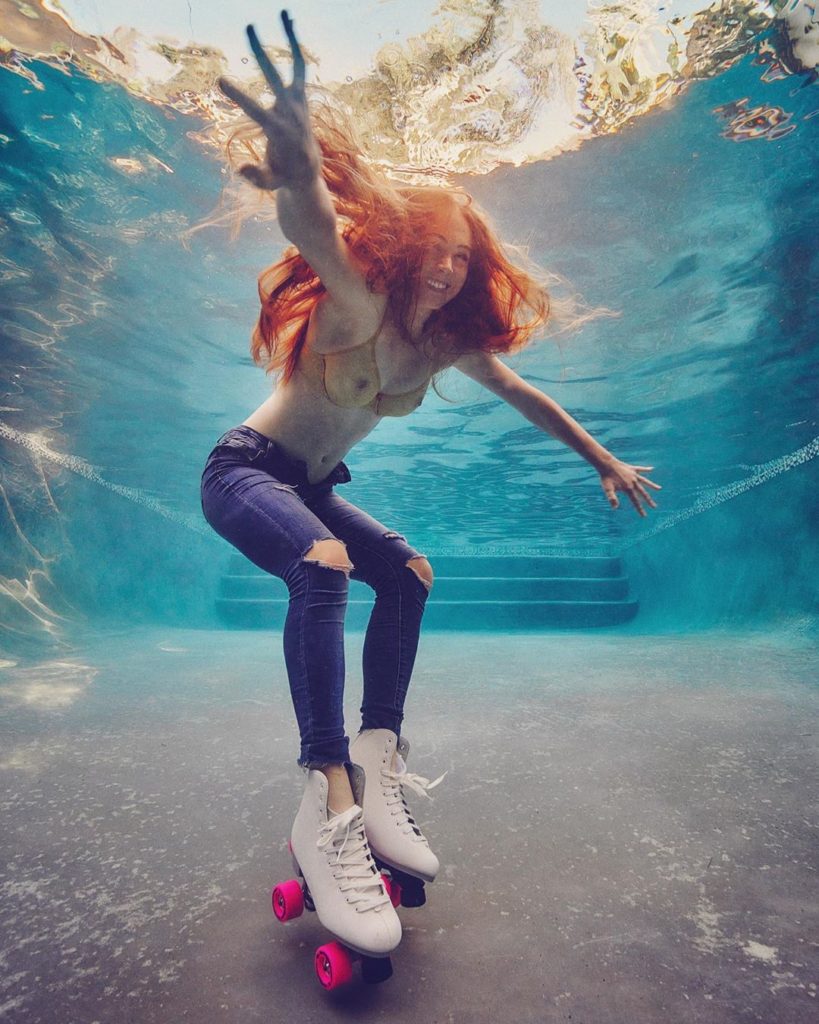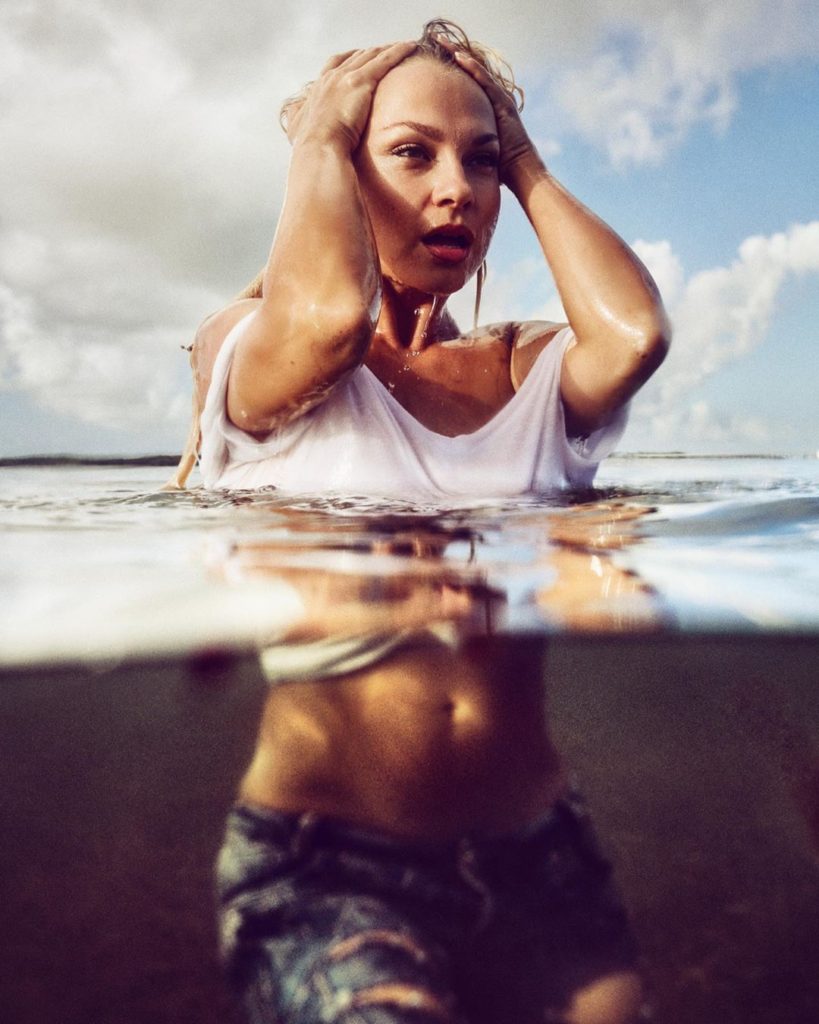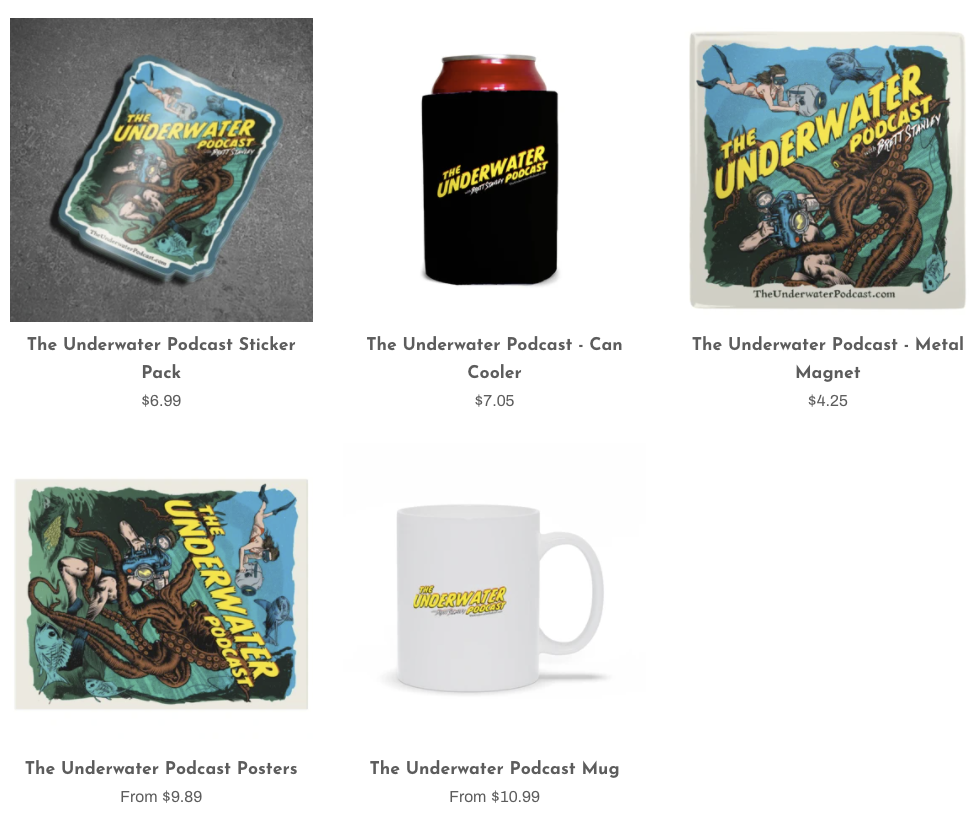Art Nude & Lifestyle Photographer Damon Loble
In episode fifteen, host Brett Stanley is discussing underwater lifestyle and nude photography with LA based photographer Damon Loble. Damon has a wonderfully lo-fi style about his images, reminiscent of photos from the 70’s and 80s, and his work with scuba divers totally reminds me of the Hardy Boy’s book covers I used to see as a kid.
Damon also works as a DIT on commercial photoshoots, a job that entails colour correcting files on the fly so the clients can approve the images – this gives him a huge head-start when it comes to grading his own photos.
We chat about the beauty of the Miami sunrise, working with models in the cold open waters of southern California, and how to perfect the elusive under/over shot that he’s so well known for.
Discuss the episode in our facebook group.
Visit our YouTube for livestreams
Follow Damon: Instagram
About Damon Loble – Art Nude & Lifestyle Photographer
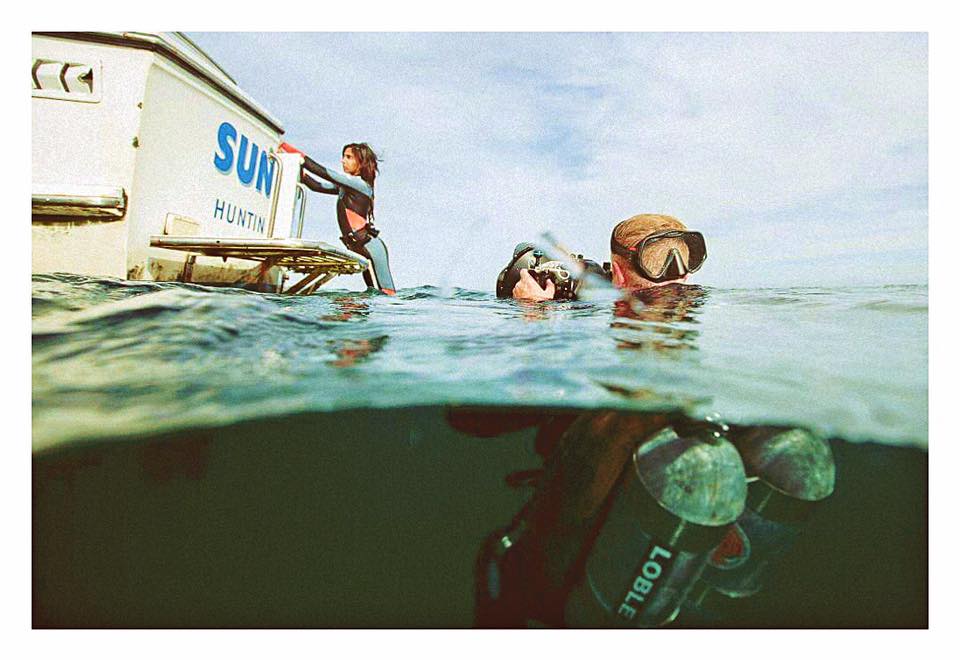
Damon Loble is a Southern California based underwater art nude and lifestyle photographer. Whether in the studio or on his travels, Damon’s Nikon cameras are his permanent companions. With a narrative, almost cinematic touch, his photographs convey this sense of intimacy and sincerity. These beautiful images seem to be the result of pure spontaneity.
Podcast Transcript
Ep 15 – Damon Loble
Brett Stanley: [00:00:00] This week on the underwater podcast, I’m discussing lifestyle and nude photography with LA based photographer, Damon Loble. Damon has a wonderfully low fi style about his images reminiscent of the photos of the seventies and eighties., and his work with scuba divers totally reminds me of the Hardy boys book covers I used to see as a child.
Damon also works as a DIT on commercial Photo-shoots, a job that entails color correcting files on the fly so the clients can improve the images. This gives them a huge head start when it comes to grading his own photos
We chat about the beauty of the miami sunrise, working with models in the cold open waters of southern california, and how to perfect the elusive under over shot that he’s so well known for .
Alright. Let’s dive in
Damon. Welcome to the show.
Damon Loble: [00:00:44] Happy to be here
Brett Stanley: [00:00:45] so let’s just kind of get into it. So how did you get into underwater? Um, was it something that you’d, you’d done? Like, did you always had an affinity for the water when you were a kid or was it something you kind of found later in life?
Damon Loble: [00:00:55] well, from a photographic standpoint, I’ve always loved water. Um, and I, you know, I’ve only been shooting underwater probably the last five years. Um, I’ve been a diver longer than that. Um, I actually got my license, I think when I was 15. Um, but you know, my regular photography always had a, an element of, you know, water let’s, you know, make things wet.
I just think water is beautiful and I, I love being in water. Um, so. Ultimately I was taking a trip to Belize one summer and I was going there to do more uh, scuba certification. And I thought, you know, I’ve got these Nikon cameras, you know, on a whim. I went to the local camera shop and bought, you know, a nice underwater housing for it to take to beliefs.
Brett Stanley: [00:01:43] And were these like digital cameras,
or film cameras,
Damon Loble: [00:01:46] it was a Nikon D eight, 10 at the time. And I went to, I didn’t know anything about underwater housings. It went to Sammie’s camera, uh, spoke to a guy who was also a diver, uh, selling the cameras. And I ended up buying a, uh, not a cam housing with the. Seven and a half inch acrylic dome and a 16 to 35, which is a lens form.
You know, I hadn’t been working with wider angle lenses. Uh, up to that point, everything had been, you know, just the standard 24, 70, 8,200, you know, plus primes, um, which turned out to be, you know, turned out to be kind of eyeopening and changed. I think my work pretty substantially after that,
Brett Stanley: [00:02:24] and so what were you shooting before you got into underwater? Is it, is it a similar sort of stuff, the same, same kind of nudes or was that something else?
Damon Loble: [00:02:32] Yeah, no, I’ve always been kind of a art nude person. And you know, when I bought the housing, I didn’t feel like I was necessarily going, gonna use it for people. I really wanted to use it as an extension of like my diving, which. You know, I was, I was, had a resurgence for, uh, about seven years ago and it was just the, you know, when you’re a diver and you understand any dive in, in areas that have beautiful underwater topography, like, you know, ironically Los Angeles has such great diving.
Brett Stanley: [00:03:03] Yeah. With the kelp fields and everything.
Damon Loble: [00:03:05] will take kelp and the light. And you know, you just, after a while, if you’re a photographer, you’re just like, kind of. Sad that you’re not able to work down there. And so, you know, the trip to Belize, which I thought would be, you know, more beautiful water. We were going to the, the, the big blue hole and I, you know, just wanting to have a camera for that.
And so I pulled, I pulled the trigger, you know, went down there, did some certifications and kind of taught myself how to use the housing. And it was so much fun. I couldn’t believe it.
Brett Stanley: [00:03:34] And what sort of stuff are you shooting down there? Was it just the landscape and the kind of wildlife stuff as you were training?
Damon Loble: [00:03:41] Yeah, well, not while I was training, but it was really the idea of just the novelty of being underwater, you know, and it’s just kind of knowing the people that sort of liked my photography. I thought this would be an interesting sort of like. No sidecar for them, just, here’s an entirely different aspect of what I shoot.
And it was exciting because, you know, you mentioned in the introduction that I’m a DIT, which means I’m pretty good at, at the color work and being underwater gave me a really, you know, unique challenges as to how to grade an image. And you see a lot of underwater diving photography that is essentially uncolored graded or.
Poorly color graded. And, and I wanted to see if I could translate my, like, you know, that seventies, retro vibe into underwater and think about, you know, the stuff we’ve seen in magazines and, and all the images we see online now, but that bring back, you know, uh, magazine scans from the early underwater work.
And it’s just, you know, the pallets were just so alluring.
Brett Stanley: [00:04:49] Hmm.
Damon Loble: [00:04:49] translated to underwater that I just wanted to try to accomplish that.
Brett Stanley: [00:04:52] Was that, that coloring, that kind of grading, was that, were you doing those kind of grades before you got into the underwater or was it something you found. And, and applied once you started shooting underwater,
Damon Loble: [00:05:04] I think that’s always kind of been, the trajectory is to have, you know, two decades of, of. Lag in what is a normal sort of color processing right now?
Brett Stanley: [00:05:16] right?
Damon Loble: [00:05:16] you know, two to three decades, I guess I just, I just liked the idea of, of something feeling a little more timeless. And I think, you know, for time timeless for me, I’m 45.
So timeless for me is obviously, you know, not too far of a step backwards, but. But, you know, we were, as we grew up, we were uncertain pallets in our images. And you know, if you’re impressionable as a, as a young man or a, as a teenager, you see things and you think, well, that’s the way it should be. And as you grow into an adult with capabilities, you kind of want to recreate in a sense, I think.
Those iconic moments that, you know, you acquired in your mind, like the images you’ve seen, that that really sort of sparked a fascination. And I think that’s where some of the grading comes from. Um, you know, and it’s just, it’s just one of those things that like, I think people have, have always said is a unique perspective in the work.
And granted sometimes it leads me into disaster with image sets, but. Uh, I think I’ve also had some stuff done. That that looks pretty great.
Brett Stanley: [00:06:22] What, what do you class as a disaster? What, what does that mean?
Damon Loble: [00:06:26] yeah, I’ll be, I’ll be flicking through, you know, a capture one session or a Lightroom session. And just realize I hate everything and nothing works, you know? And so you put it away for a few months and you know, sometimes you, you want to go back and see if you were really just angry that day, or really nothing works.
And you know, a good portion of the time, nothing worked that day. So, you know, you just put it away again.
Brett Stanley: [00:06:52] Right. And I think that’s a, that’s a pretty common thing for photographers in general. I think where, where you look at your work and you think this is not what I wanted to do, this is not what I was aiming for at all. And you might come back to it like a week, a month, a year later, and with new eyes and, you know, I mean, for me, like 50% of the time, I’m finding stuff that I didn’t even realize was there, but that I’d written off the day I shot it.
And I think we’re so close to our work, sometimes that we kind of can write it off just because it didn’t quite go to plan.
Damon Loble: [00:07:24] it’s true. I mean, it’s funny because like every time, you know, I work primarily in capture one for the initial grading, but every time. They released a new version. They seem to substantially change the color engine and you end up developing a new set of grades, like sort of a new set of, you know, homemade presets that you use to start a grading on an image.
And every time I do that, actually think about the images that like failed me. And I’ll, I’ll go back to them, upgrade, you know, the session and upgrade the processing engine for it and apply new grades. And I’ve actually found a few things just through, you know, technology improving or, or whatever. But, you know, sometimes, you know, as your work evolves, you could reach back and rescue things that, you know, you might have like dismissed
Brett Stanley: [00:08:15] I think that’s, that’s such a good way to look at it too, is that as it’s not, you kind of changing so much as your tools, changing that, give you a new person.
Damon Loble: [00:08:24] Yeah, I actually think that’s a great way. Great way to put it. Sometimes you’re just maybe not in the right head space for what you shot that day. And, you know, obviously if you’ve dismissed it twice over and you go back and you find something that works, it probably wasn’t your best work to begin with.
But you know, maybe now with a new perspective, you know, essentially tools for grading. You find something that is kind of interesting and it does kind of shift, maybe this was a great idea back then, or this was an acceptable idea, but how can I make that better? And, and it kind of informs like, you know, your next three months or four months of shooting,
Brett Stanley: [00:09:02] So say, if you did go back and, you know, reworked some old images that you did, and then you’d like to what you did with the new tools or the new upgrades, would that change how you then shoot and edit from then on?
Damon Loble: [00:09:15] possibly. I mean, not always, but yeah, certainly, certainly. I mean, I think that, you know, the underwater shooting is still low enough volume that I can remember, you know, the specifics of generally every shoot. Um, and so when you find something that works, that, that suddenly. Does work or maybe, you know, if you’re lucky works spectacularly well on her new grading system, um, you kind of want to see if you can replicate it with, you know, fresh people or fresh vistas and, and improve on it.
Brett Stanley: [00:09:49] Yeah, I think that’s, that’s a great way of looking at it too, is just, you know, constantly evolving and kind of rolling these things into your workflow, um, as, as the tools and everything kind of evolve as well. How would you actually describe your style? Cause to me, it’s got such a, um, unique and very distinctive look.
How would you describe it?
Damon Loble: [00:10:09] I guess I would describe it as somewhat aspirational. I mean, I’m, I’m not a fashion person and I’m. Certainly not, you know, a commercial photographer. Um, and I’m not a fine art photographer. I just think that I make images that I enjoy or rather I make, I try to create images that, like I said earlier, represent or are pulled from like those iconic images that I’ve seen.
And that I really was attracted to. So it’s like, I’m always chasing the tail of, you know, these greats and these people who created these images may have only produced like five great images in their lives, or they might’ve produced 5,000 great images, but the five images from that person that I’ve seen, you know, inform.
You know, so much of my work down the road. It’s, there’s, it’s, I think it’s like an, an attitude or a moment just in that image that I latch onto. And that’s, you know, that’s what I’m going for. So, you know, realistically I think my work is maybe bent more towards camera aficionados, people who enjoy photography.
I don’t think that. I will be a critics, darling. I don’t think that I have high, like high conceptions that are really pushing the medium forward. But I think that I create this, you know, general atmosphere where, you know, someday, you know, it could be in a sexy hotel, Marriott, you know, style artwork on a wall somewhere.
Brett Stanley: [00:11:44] Oh, totally. I mean, I think like your style to me is kind of more ACE hotel. Like I think it’s got that kind of, I haven’t heard you say the word vintage or retro, but that to me is it’s got that kind of bent. To it, like there’s a bit of a seventies, eighties kind of film flavor in there.
Damon Loble: [00:12:01] yeah, I like, I would prefer nostalgic over vintage or retro and I, and, but I mean, obviously I use the most modern tools available, um, to, to produce it. I’m not, I’m not a film shooter. I don’t use vintage lenses. Uh, I use, you know, the most recent version of capture one Photoshop or, you know, occasionally light room and it’s, it’s, it’s a massage process, but you know, it’s also an organic process in the sense that half of the look, you know, comes from using retro tools, like heavy filtration on the lens and just various things that can.
You know, interrupt a perfect digital capture. And, and so that’s done, you know, in the spirit of creating a, you know, an established and I recognize not shooting on film. I’m not ever going to fully recreate that. And I don’t want to, if that’s not my thing, but what I want to do is, you know, take our modern world that we, you know, photographic world that we live and work in and just bring the.
Elements forward that I enjoyed so much from the seventies, eighties and nineties, sixties, I guess even that was just, there’s so much wealth of just color that, that the history of film photography has given us, but we can, you know, we don’t have to be stuck in, in Instagram level pilots. We can do more interesting work and still, I think be relevant.
Brett Stanley: [00:13:31] Oh, for sure. I love the way that you’ve. Kind of defined it by a certain word, you know, like nostalgia, I think it is totally different meaning than vintage and retro. Like nostalgia I think is, is, is remembering that thing. Whereas vintage and retro is just there was then,
whereas I think what you’re doing is really merging two worlds, um, you know, using this technology to create these, you know, high resolution images.
But then running them through the nostalgia, like kind of basically, I don’t know, marinading them and flavoring them with the memories and the time that you kind of associate most with, or have a love for. And then these images come out. The other end, having this really unique kind of bent, which I think is beautiful.
Damon Loble: [00:14:16] Yeah. I mean, thank you. I mean, it’s like, I imagine like, you know, one of my greatest, influences would be slim Aaron, and, you know, if he had been shooting, you know, underwater the level, that he was shooting above water, I think that, we would have, An order of magnitude more underwater, fashion photography, somebody who has, you know, who captured, the bombs Vaughn of, his day in color, in an underwater setting, you know, slim Aaron could have, could have redefined everything.
Brett Stanley: [00:14:48] Yeah. What sort of thing was he doing? I’m not familiar with his work, but, um, what sort of era was he in?
Damon Loble: [00:14:54] He was like sixties, seventies, eighties. Uh, he was sort of the American Helmut Newton. he started off doing these immense families like family. Uh, portraits in Bel air and Beverly Hills and then moved into fashion and then ultimately moved to Monte Carlo, uh, on the French Riviera.
And some of his beautiful, most beautiful work is just this, you know, lifestyle of the, of the South of France, essentially
Brett Stanley: [00:15:24] Oh, well, yeah.
And that’s pretty
iconic.
Damon Loble: [00:15:27] yeah, it’s completely iconic, you know, just big, old, big spaces. Lots of people, beautiful people. Of course,
Brett Stanley: [00:15:35] And so, so how do you deal with. With working with people, um, you know, the, your kind of reasonably intimate kind of situations with, with models, mostly female models. Do you do stuff with male models as well?
Damon Loble: [00:15:48] I don’t typically work with men simply because it’s really hard to find men who are. Comfortable like that. I mean, it’s, it’s obviously some people do find, find them very easily. Um, I’ve not had an opportunity to really, you know, do that. Uh, some of my dry work, I guess, has had some, some decent men. Um, but I mean, I would absolutely love to somehow figure out how to incorporate the male into the image sets, you know?
It’s definitely. Yeah, it feels, it definitely feels like overweighted and it would be fun to balance it out.
Brett Stanley: [00:16:26] I think it’s just from my experience of shooting with males and females, it’s a very different way of directing and shooting with a male than a female. It’s I’m not sure what the difference is, but I definitely feel maybe I’m more conditioned. By society to know what looks beautiful with a woman, whereas I’m not conditioned so much with men, and I’m not sure if, if it maybe it’s just a lack of experience, but that seems to be for me where it kind of, there’s a definite transition.
You can’t use the same sort of, um, techniques or tricks or skills to get them to kind of give you the poses that you want. Have you kind of came across that in with the men that you have actually worked with?
Damon Loble: [00:17:05] Yeah, I think so. I mean, I think we ended up, you know, when we, when we’re unsure, we end up defaulting to. You know, our gender perceptions and you know, every time I photograph a guy, you know, I want to make him look stronger, resolute, you know, it’s just like, and it’s a little bit concerning that, you know, I have those gender MIS you know, I don’t wanna say misconceptions, but I have these gender perceptions of how to photograph people a certain, certain ways.
Um, and you know, it’s probably. One of the weaknesses of my work realistically, is that I don’t have this fluidity to be able to move back and forth, you know, seamlessly.
Brett Stanley: [00:17:47] I think it’s, it’s very a societal thing where, where. You know, we, we pick up all these things from advertising or imagery or whatever, they kind of, that’s what we fall back on.
Damon Loble: [00:17:57] I agree.
Brett Stanley: [00:17:58] let’s talk about your actual kind of working. Kind of style, like your workflow when you’re shooting underwater. Um, how do you kind of start, are you thinking of concepts beforehand or are you just kind of getting to a location with a model and then kind of working it out from there? How much forethought goes into, into these images?
Damon Loble: [00:18:16] um, I’d say it’s a pretty. Strong mix of zero forethought to some forethought.
Um, anybody who knows me or has worked with me is probably had to deal with the, the, my lack of preparation and, you know, imagination. And I think. And, you know, people will ask for mood boards and I don’t have a mood board. I don’t, I have five or six images, you know, like I talked about earlier that like really what I’m after in my life.
And those are the five or six images that I’m always pulling, you know, or trying to recreate one aspect or another. So.
Brett Stanley: [00:18:54] So it’s fairly organic in terms of how you create stuff.
Damon Loble: [00:18:58] Yeah, it’s organic in that sense, in that I’ve come to rely a lot on the creativity of the people I’m working with. And some people are so good that they, you can’t help, but be brought, brought up to their level in a way, you know, they just, you look at certain sets of images I’ve done and it’s, uh, you know, I, I look at it and I’m extremely like, Gratified, when I look at these images and then you just, you have to realize that it wasn’t so much me was really that I happened to have this particular individual who was very good at playing in that role or, or becoming that atmosphere that, you know, the image is.
And, you know, some, some directors, some photographers. Can take their own energy and like bend the world around it. And I’m not that person, I’m the person who, you know, really just tries to carve a piece out of it out of what’s going on.
Brett Stanley: [00:19:58] And so you’re kind of taking, what’s given to you and then. And then dealing with that and kind of interpreting that through the lens, as opposed to, as you say, someone else kind of basically shooting all their energy out to control everything else or not even control, but to, you know, direct everything else.
Damon Loble: [00:20:14] Right. And you can get away with it. If you have a technical proficiency with your equipment, which I do, I feel like technically I’m proficient. Um, if you, if you weren’t proficient with equipment and you know, a good example would be, give me a motion camera in the water and you know, all hell breaks loose because I’m not proficient, but with stills, I’m.
Extremely confident in my abilities to use the equipment, not necessarily getting great image, but I don’t feel like my operator skills as a photographer, hold me back. So, but sort of definitive question is, am I going to be able to sync with the person well enough, their energy and their, you know, to create a set of images?
If, if we get along in the water, if we have this ability to kind of understand where we’re both going with stuff, then we, we get great shots. And if we can’t develop it, then we might get something that’s technically good, but not something that you’re, you know, extremely like enthusiastic about.
Brett Stanley: [00:21:21] Right. Yeah. I think that’s a, that’s an important point. Is that knowing your gear and knowing how to do basically your job, which is the taking and the creating of the images is so important to having a good final result, because it means that you’re not so concentrating on what you’re having to do.
You can then. Kind of work with the other person, the model or whoever it is to kind of create this image between you as opposed to freaking out because the settings aren’t what you’re used to, or you’re not being able to, think of two things at once. I like being able to direct and also think about composition. I think sometimes it’s, it’s the people who jump into this kind of underwater world and think that they’re going to be able to create stuff amazingly, straight away, but then they’re struggling to use their equipment, which, um, I think know, just having practice and getting in there and kind of learning basically your end of the deal makes it so much easier to create everything as a whole.
Damon Loble: [00:22:18] Yeah, absolutely. when you don’t look like you’re struggling, I think that it reflects backward or back to you.
You know, from your talent and they see that you’re competent in the water and there they feel more free to do what they want to do. Cause you know, they’re aware that you can probably follow them through what they, they feel like doing.
Brett Stanley: [00:22:38] So I think you bring up a great point. They were it’s if you’re not as comfortable and as solid in the water, then they’re not going to be as solid either because they’re looking to you as basically the leader of this, uh, kinda project, uh, they’re looking at you to kind of keep them safe and to kind of keep them reassure.
So if they’re not as experienced as you, I think sometimes, um, They’re really relying on you a lot to get, get them through it. And that kind of leads us into shooting into open water as opposed to shooting in pools and tanks and stuff, which I know you do a lot of open water stuff, um, with boats and, and kind of getting out onto the islands around LA, how do you, how do you find the differences between that and how do you get your models comfortable in those environments?
Damon Loble: [00:23:23] Um, that’s a really great question, uh, in shooting in pools and LA is, is nice. It’s beautiful. Um, one of the things you have to worry about when you shoot in a pool is, is a, is it filtered? Uh, B as it aerated, um, with a bunch of micro bubbles,
Brett Stanley: [00:23:37] Oh, I love Oh, I love the micro bubbles.
Damon Loble: [00:23:38] yeah, the micro bubbles. See, what’s in the background because you, you know, you mentioned, I do a lot of above, below splits and, um, shooting in pools.
You have to have sort of all of this kind of working for you. You can have a beautiful pool, uh, clean, crisp, clear, warm, even that’s comfortable. To be in, and then a background that just is so phenomenally bad that you can’t work in that pool. And you know, for me, like, you know, I, I, I’m not like you where I have the ability to, to imagine these really amazing sets.
I shoot an environment that is the environment, which is a pool. And honestly like, the, the creativity is how I work with. The light and, and incorporate the above below with the background on the environment of the pool, not, you know, the pool as the stage, you know, with a set on it. And so shooting shooting just underwater for me in a pool is kind of boring.
Like it’s just, it doesn’t the, the elements I need to make a successful picture. Generally. Aren’t there there’s been a few I’ve had that are okay. But generally speaking, you know, I can’t do what you do with your underwater stuff.
Brett Stanley: [00:24:52] But I think what I think what you’re doing is, is more grounded in reality. So a lot of like you’re using what’s already there and making a story around that. Whereas what I’m doing is basically creating something that’s not there.
Damon Loble: [00:25:06] Right, exactly. So you take a pool, which is a confined location, a lot of controllable elements. Um, the ability to really reorient a subject. If the background is amenable to, you know, you know, pivoting the camera one way or another, um, makes for an easy lots of shots day, you know, we keep trying stuff till we get it right.
Whereas when we go to open water, like, you know, the channel or off the coast of the islands, um, we have an entirely different set of. Circumstances, like, first of all, we know the water isn’t going to be as nice, but that’s kind of, that becomes a characteristic of the image. Like, you know, it’s not to loom, it’s not Cozumel.
We don’t have this perfect blue water. We have sometimes really nice water and sometimes really lousy water. Um, we also have cold water. So when I. When I select models, I honestly, like I have to ask, like, you know, how brave are you? How, willing to go for the shot? Are you, and, you know,
Brett Stanley: [00:26:06] And I th I think that’s what sets a lot of that, that open water work of yours apart is that these models seem to be fearless. Like they’re in this, I don’t know what, like, you know, mid sixties, seventies degree water, and they don’t look like they’re cold. They don’t look scared. I think is incredible.
Is there something that you’re, you’re sort of teaching them and training them when you’re out there?
Damon Loble: [00:26:27] Not really. I mean, again, it’s, I think you, you hit on it. You provide a certain amount of, of leadership, or just example leading by example. And I know like, you know, I’m a, I’m a little bit heavier guy than these girls. I’ve. Significantly more body fats on insulated. And I’m used to being in this water temperature it’s, you know, even as a, as a diver, even though I typically would wear dry suit, if I was diving out here, um, you know, in the summer months I will, I will just be in my swimsuit as a solidarity who a lot of these people, especially, you know, when you’re free diving just makes it so much easier.
Brett Stanley: [00:27:03] Yeah, there’s Yeah, there’s a lot less drag and yeah.
it kind of thing. It makes some models feel better if you’re freezing as much as they are, or you look like you’re freezing as much as they are.
Damon Loble: [00:27:11] for sure. Um, but then these, these girls, they just, they have to go go hard. I mean, realistically, like the most successful images I’ve had out in the open water have been from people who, who just go for it, you know, they will shoot for 20, 30 minutes out in the water during, during, you know, a, a three dive day.
And there’ll be amazing. Like the first dive, you know, it was a shock. The first time I jumped in is a shock and then they acclimate and then they, we shoot a 20, 30 minute session and then they get out of the boat or get out of the water and onto the boat where it’s warm and sunny and they fall asleep for the second for the second diet.
I mean, you know, it’s just, that’s just the nature of it. You can’t. put somebody in this environment for 30 minutes and expect that they’re going to go all day. It’s just, you can’t do it. So when you shoot, you just have to understand that like you are going to have fewer shots that day. And you know, a few boats out here have hot tubs on board that do really help, you know, help people sort of recover.
Um, but that second dive is never going to happen. You know, you’re only going to be shooting on two dives, generally speaking every day. And, and, you know, but the third dive is, you know, always a magic dive cause they’ve, they’ve warmed up. They know what they’re excited and, you know, assuming the weather hasn’t turned against us, they go in, you know, with an attitude of like, this is the last day of the day, let’s do something really great.
And like some of my best images, I’ve always banned from that third dive. After, you know, a practice morning, dive. It’s just, everybody seems to be maybe it’s that they’ve had lunch in a nap, but they’re able to go and push everything that last thought.
Brett Stanley: [00:28:53] that’s amazing. Cause I think they’ve like you say, they’ve kind of built up to it and I think knowing the environment as well, like knowing the things that they can play with. Cause there’s, I see you use the, you know, the anchor line from the boat a lot and you’re up on the shore of the islands and kind of getting those half and half shots.
Is it them just sort of getting. More comfortable with, with all those environments.
Damon Loble: [00:29:15] it is. And it’s also like, you know, it’s a pretty magical thing. Like most people don’t get to ride up and down on a, on an anchor line as the boats, you know, bobbing in the ocean and, to swim 200 yards from a boat, in the open ocean to a remote shoreline is a challenge. But it’s also kind of a, uh, you know, it’s kind of a treat like this.
Isn’t something they get to do every single day.
it’s the experience. And I think that’s, you know, the other part of the draw is that you’re looking for people who are willing to step out of that comfort zone and go for it. I’ve had some days where like the people just, you know, say they’re, they’re good for it.
And they get out there and they. It turns out for whatever reason, it’s just not something that they can handle. And I can respect that because it’s, you know, it’s hard to bring yourself to jump off a boat. Sometimes I’ve, I’ve been, a diver with tanks and not wanting to jump off a boat sometimes.
So jumping out off a boat with very minimal protective equipment, if any, you know, it can be daunting. And part of, part of shooting it for me is also the exploration of like seeing a person, um, sort of come into their own, doing that. Like, it’s just, there’s something really unique when you see somebody who is a little bit nervous and, you know, people don’t generally like to admit that they’re nervous.
Mmm. But you can kind of see it and, you know, I’m nervous on the first dive of every day. Anyway. And, and so I understand it, but watching somebody jumped into the water and suddenly become comfortable and, creative after having not been that way previously is really rewarding. And then, you know, they have a two hour ride back to the mainland to take a nap at the end of the day.
Brett Stanley: [00:30:59] Have you done any of these kinds of shoots in warmer water? If you have you had models like say in Miami or, you know, back in Belize or anything.
Damon Loble: [00:31:08] I in Miami, I have, I haven’t shot off of a dive boat. Um, Miami is like probably one of my most favorite places to shoot in the water just simply because it’s such a shallow, uh, sloping shelf that as you weighed in, um, you can play in the waves. from the shore, but it’s just, there’s something just, I have, Miami has a special place for me there.
I just love the water in Miami. And even though I’m constantly worried, a bull shark is gonna tear my calf off it’s it’s like everything I’ve shot out there is just amazing to me.
Brett Stanley: [00:31:40] Right. Do you feel like you get different style of shots out there? You’re getting different things from the models because it’s a warmer water or is it still kind of the same dynamic?
Damon Loble: [00:31:49] I think the water, because it’s warmer, the models are much more comfortable and because it’s also a gentler, um, you know, if you want to be out in the, in the surfer, in the waves in Miami it’s you can get like the rolling, characteristic of the water. With the model in Miami, because it’s not coming into punish them.
Like it would be in, in Los Angeles. You know, I, there’s no way I’ll take, uh, one of my housings out into that mid surf zone in LA, because you just, you get hammered and, and Miami is just, it’s this gentleness that, I just love. And especially if you wake up early in Miami and you could shoot the sun rising.
There’s just something so beautiful about that rising out of the water versus setting into the water.
Brett Stanley: [00:32:35] Well, so that’s an interesting point as well as it’s lighting wise, do you tend to use use lights or are you just sticking with what’s natural? And if it’s natural, is there a certain time of day that you prefer.
Damon Loble: [00:32:46] yeah, I’m primarily a natural light photographer. Um, I, you know, or. For proper diving, I’ll bring a set of hot lights. Uh, you know, I’ve got, I’ve got killed in lights that I’ll rig off my camera and their video lights. And they’re, they’re color about, you know, they’ve got filter systems on front of them to balance the magenta back to like the, the water tone so that when I do sort of try to grade back to.
A white point plus sort of nostalgic feeling. I don’t have a hard magenta cast and you need sort of like skin tone or reflective white surface from the lights. Um, but you know, you also deeper down and having those lights does help pop out the black details in the diver’s suit or diapers equipment and just separate things.
So they’re not just the, a black mass with a pair of eyes. Um, but otherwise when I’m shooting models in the water, I’m never deeper than 10 or 15 feet maximum. Um, I’ve I’ve yet to shoot somebody who’s as accomplished a free diver as I am a scuba diver. And if they were an accomplished free diver, I don’t think I could follow him as deep as they would want to go.
Brett Stanley: [00:33:52] bribe. Do, do you take models down and have them on regulators and, and, um, kind of buddy breathing down there or is, or they all sort of swimming down to you and then going back up again.
Damon Loble: [00:34:02] I have them swim down. I’m just, it’s too much of a liability to ask somebody, to use compressed air under water. Uh, unless I knew that they were competent scuba diver in their own. Right. It’s just, you know, there’s just, it’s not, it’s not safe. It’s not intelligent. Um, I’ve done it in a pool, but, but mostly because I wanted to have them on scuba in a pool and just,
Brett Stanley: [00:34:22] specific look you were going for.
Damon Loble: [00:34:25] Yeah.
But.
Brett Stanley: [00:34:26] let’s kind of talk about the, the deepest stuff you’re doing. So you do so outside of the art nude kind of stuff, you’d also do kind of what I call diver lifestyle shots, but it’s mostly around the gue, which is the global underwater explorers. Is that right?
Damon Loble: [00:34:42] That’s that’s right. Um,
Brett Stanley: [00:34:44] Talk to us about that. Cause I find that sort of thing quite fascinating. And it’s such a contrast to your other work.
Damon Loble: [00:34:50] well I think realistically, like, you know, my work, like I said, my work isn’t ostalgie based, and I think that the nude. So the model nude surface, you know, just below surface stuff. And then the diver in the G we style tech diver in full gear, sort of play the, like my, my aspects.
Um, there’s something about the nature of like man wanting to explore and be. the dominant species on this planet, like the fearless adventure. And when you take divers who are trained pain, technical divers, and then you take, or especially divers who are trained in the GI system, the global underwater explorers sort of like regimen.
You have people who look really, really good in the water. And I know we, we’ve all seen photos of divers that are like cattywampus upside down, vertical in the water. And, you know, we don’t understand that that is actually poor form of diving until you see real trained tech divers, doing their craft underwater.
And these guys, when you, when you get them together as a group, Working because they tend to work together as a group when you get them. It’s like, there’s just something magical about showcasing off the teamwork and the discipline and like the, the gravity of what they want to do underwater. Um, there’s a, there’s a hero worship.
I think that kind of goes into the ability to use what seems like extraneous equipment underwater. But this equipment exists because they take this, they take their diving to such a, uh, a level and a depth of seriousness that it’s necessary to have it. And then to see them handle it with such finesse and to make these, these controlled subtle movements in what is, three to 400 pounds of gear sometimes. You know, on, in, on dry land to see them do that, underwater is, is just, it’s poetic.
Brett Stanley: [00:36:57] And the, the times that I’ve seen them, um, the gue divers they’re, to me, they’re kind of like a mix of, uh, like a paratrooper and um, uh, like a Hardy boys kind of novel cover, but all underwater. So it’s for the people listening. If you see a gue diver there, they’re basically looking like.
Like military, no, in the colors and the style and stuff, but just how kind of regimented they are. And every piece of equipment on them is there for an exact reason. Sometimes they got two or three of everything. Um, it they’re very imposing under the water in there. So, um, I guess, yeah, like you say, regimented in the way that they float in the water, that they are dead horizontal and just have this beautiful form.
Damon Loble: [00:37:37] Yeah. And it’s from a, from a photographic perspective, it just, it’s just so interesting to watch them in the water. And, you know, it was the reason I began training with that same agency, but like, there’s just something that, to photograph divers who are not, gee retrained is completely. Um, interesting to me.
I know that sounds really elitist and really, um, probably asinine, but it’s the same reason we photograph models versus, you know, any old person, you know, off the, off the
Brett Stanley: [00:38:11] look, there’s a characteristic that you’re
Damon Loble: [00:38:13] There’s a, there’s a character that I’m after. And I think that is encapsulated in that, you know, the training and like the mentality of the GRE diver, um, And again, I bend it back towards the model.
Like the models I worked, worked the best with seem to be able to come up with this character. And you know, it’s not the world conquering, you know, underwater Explorer, character. It’s just, they, they, they are able to come into a character that gives me that same sort of like tingling sense in the brain when I, when I’m working with them.
Brett Stanley: [00:38:46] I totally, I think what the, what you get out of your models, both divers and, uh, the art nude is there is this sense of, there’s a sense of confidence in them. There’s really very rare that I look at one of your photos and look at someone and they look overly vulnerable. They tend to look powerful, at least in control.
Damon Loble: [00:39:05] In control, I think is a good word. Yeah. I don’t think that that powerful, you know, I’m not looking for powerful people, but I’m looking for people who are. In control of what they’re, seem to exhibit control over their atmosphere, their environment.
Brett Stanley: [00:39:20] And with your, with your commercial work. Cause I know you’ve done a little bit of commercial work, but mostly for dive brands. Has you, have you done much of that?
Damon Loble: [00:39:30] Yeah, I’ve seen some, again, a lot of it because you know, up until recently, you know, with COVID, uh, I was, uh, working DIT and haven’t had need to have a huge commercial client base for my, myself. Um, most of the dye brands. Don’t want to shoot the way I want to shoot. So it’s generally uninteresting. I’ve had a few die Browns tell me that they need to use, they need models who are less attractive, uh, because they, they feel that the way I was shooting was unrealistic to the demographic who would use their products. that was kind of a turnoff and it’s, it’s, you know, I enjoy photography. Like I, I truly enjoy photography and I, I don’t want to change what I do just to make a paycheck. It’s too important to me to change the way or my approach to shooting, just to make a few dollars. That’s that said there are some clients who, who are completely, you know, pour it. And those are the people you want to work with. And I suspect that every photographer.
World over feels exactly the same way and some are better at bending themselves. And if you’re the kind of person who is willing to bend yourself, I mean, it’s fully valid. That’s because that’s the way you think. And it’s the way you feel. And I’m not disparaging that mentality at all, but, you know, knowing myself, I just can’t really get up in the morning to shoot something that I’m really uninterested in doing, or, or don’t kind of believe in.
Uh,
at the end,
Brett Stanley: [00:41:04] And do you think that would show in the final work, do you think it would not be as powerful as the work you are invested in.
Damon Loble: [00:41:10] I think so, but that could also be the lazy part of me saying that. I mean, it could be that, you know, you become invested if you care enough. And maybe what I’m saying indicates that I just don’t care enough. to be quite honest, But again, because it’s not my primary source of income, I would prefer to have the photography still be a place of my personal growth.
You know, the stuff that I like to do.
Brett Stanley: [00:41:35] And I mean, that’s why you started it. Cause it was somebody that scratched an itch inside your head and it was a way for you to create. Um, and if that creation is not, you know, kind of reliant on you. Putting food in your mouth, then it certainly makes you a lot more flexible
in that lifestyle.
Damon Loble: [00:41:53] It makes me, makes me flexible in the lifestyle is a good way to put it.
Brett Stanley: [00:41:56] Um, so that’s, that’s really cool. I mean, I love that that you’re sticking to your guns and the, as you say, there are photographers who will be flexible in their, their work life for their clients. And I think you have to be. To be able to do a range of clients, but there’s also photographers who are strict in what they do, and that’s why they get hired because they only do this thing to a certain quality.
You know, people want them to do their projects because of how strict they are and how much they won’t bend.
Damon Loble: [00:42:27] I think that’s true.
Brett Stanley: [00:42:28] We’re kind of coming to the end of this now, but what I want to kind of get an idea from you is, is there any kind of tips for people working with models in the way that you do? Like are there ways that they should be approaching these models? Are there ways that they should be talking to them?
Are there things that they should avoid? Obviously it’s, it’s a, quite an intimate style of photography. What are the kinds of etiquette things that they shouldn’t be doing or should be doing?
Damon Loble: [00:42:52] I mean, I think it’s just basic instinct. Like if, if you feel like you are verging on something that’s inappropriate or you’re verging on something that’s. Uncomfortable. Um, then you don’t go there. And I think that you, you constantly ask your models like about their comfort and you give them many opportunities to be like, no, like this is too much, like I’m not happy in the water right now, cold nervous, you know, let’s, let’s not shoot this.
Um, I think it’s just a constant, always checking in, um, You know, honestly, every few minutes, just make sure that they feel like you actually, give a damn about where their head’s at. And then beyond that, don’t be a jerk.
Brett Stanley: [00:43:36] Yeah, I think that’s the main thing. Common sense. And don’t be a jerk.
Damon Loble: [00:43:41] Um, uh, specifics, you know, if you, if you are shooting in the open water and make sure you have some kind of flotation for them, so that they’re not treading water, you know, in the off time, um, I bought five of those long foam floaty, lifeguard, uh, rescue buoys, and they’re incredibly useful for just hanging off of, in the water.
And you know, when you’re hanging off of it, you’re, you’re naturally buoyant. And it, it can be comfortable, everybody relaxes, and you can actually enjoy the fact that, Hey, maybe you’re naked floating in the Pacific ocean or B you’re just not getting tired from, from kicking. And if you’re, you know, from a, from a gear perspective, if you are trying to do splits in the middle of open water, cameras, underwater housings with their, their large domes are very heavy.
And if you take that. That buoy and rested between the dome and your body. It’s a, it’s a perfect balance for, you know, getting the camera on the split level. You want, I’m trying to do it without that. You’re constantly finning. And, you know, as you’re finishing your, your, you know, and invariably you’re pushing yourself out of position.
Brett Stanley: [00:44:48] Yeah.
And tiring yourself at the same time.
Damon Loble: [00:44:51] entirely on yourself.
Brett Stanley: [00:44:52] it kind of is a good kind of thing to finish on because the under overs that you do and I’ve tried to do these and they are not easy from my point of view, but you make them look so easy and there, I mean, you just gave us a couple of kind of tips then, which is putting a float under it and keeping it up for doing the under overs.
Is there any. Any technique that you kind of think is, paramount.
Damon Loble: [00:45:17] Uh, the bigger, the dome, the better honestly.
Brett Stanley: [00:45:19] Yeah.
Damon Loble: [00:45:20] you know,
Brett Stanley: [00:45:20] What are you shooting on? What kind of dime if you got.
Damon Loble: [00:45:23] I have two systems. I have not a cam, uh, housing for and then I have another camp housing for my, uh, da 50 and I have a 180 mil dome and I have a 240 mil dome. And the over-under is on the two 40 mil are. So much easier or so much better, you know, again, the problem is that two 40 mil down is, is extremely front weighted.
So if you don’t have support in open water, uh, it’s a beast. So if you. If you want to just do work in the open water and you don’t want to have to carry a float around, I’d recommend the 180 mil style dome or the, even the, the a seven and a half inch acetate, which is a really light dome and actually a very nice dome.
And, and it’s the most affordable volatile, um,
you know, it’s, I think doing a split is a function of just finding the sweet spot of focal length and water clarity. So. You know, I’ve had a few times where I’ve been able to somehow, and then, you know, it’s a miracle when it happens, but you’re able to, to find a convergence above and below where there’s virtually no magnification, even though a dome is supposed to give you that there, you know, depending on focal length, going to get some magnification or some diffusion of the image above and below.
Um, so finding that sweet spot, which can be for me, it’s about 30 millimeters. Um, on the 10 inch stone is kind of where I can pull strong detail around F eight F 11, um, you know, above and below and make it feel as if it’s just the water is glass
Brett Stanley: [00:46:55] And do you need that, that kind of small aperture to be able to get the above and the below to kind of match, right? If you can, if you go too wide, an aperture, you start to get too much difference between the two.
Damon Loble: [00:47:06] Too much, but I mean, you know, there’s a photographic, aesthetic to that as well. Um, but some of my favorite shots are when the water just sort of disappears. And again, we talked about, you know, I mentioned like the nature of the background of the pool. You can’t have, uh, if you’re going to do something like that, the, at an 1130 mil.
Everything’s going to be generally really sharp. So you need to make sure that the environment behind you like accommodates that level of detail
Brett Stanley: [00:47:35] Yeah, that’s actually interesting and nice and adds to the photo as opposed to being some sort of ugly swimming pool or backyard.
Damon Loble: [00:47:43] yeah. And then, you know, the other things is you just obviously have to pay attention to like, do you have. Light that works above and below. Like I’ve, I’ve blown so many images where, you know, the light above just is so beautiful and I think everything is great. And then, you know, when I go to process the images, the light below, just for whatever reasons of her refraction, just, it just falls to like muddiness and it, you know, it doesn’t work. So, you know, it’s just. Hanging a lot of attention and, you know, you know, it’s easy to get caught up in the moment when you’re shooting and, and spinning and moving. And, and you wind up in a situation where like they have water droplets at the, on the, on the dry side of the dome that ruin everything. Or, you know, like I said, the light doesn’t work below or the light where it’s really well below.
And that’s what kind of you’re focusing on is like this incredible lighting that’s going on below. And then above it’s just like, It’s broad and the angles too high, and everything looks like blown out. It’s, there’s a, there’s a lot of maddening aspects too. You know, sometimes you’ll look at the back of your screen and think like, we’ve nailed it.
And then you get in, to post-process the image and you realize like you blew everything because there was a few small details. You overlooked
Brett Stanley: [00:48:56] Yeah. If you’re in a shoot session, are you saying all right, let’s do some under overs now or is it kinda like the throwing one in every now and again, just as you see something that’s going to work.
Damon Loble: [00:49:06] Well, pretty much everybody who, who wants to work with me, I think, is looking for that shot or they want an under, over somehow.
So, you know, it’s like, you know, as a one trick pony, um, I kind of feel obligated to do it. I mean, I love it. I mean, it is, you know, but, um, um, I just always assume we’re going to be getting in the water. Um, I never start in the water. I want to start dry. Uh, part of it being like, I’m not a photographer who’s instantly on, um, I need to take two or 300 images before, like the good part of my brain sort of kicks in. So I need that.
Yeah. I need that ramp up period myself. Um, It’s also good too. If you want to have dry shots to shoot them before obviously hair or makeup is ruined. Um, also once you put a, put a person in a pool, especially, you know, a model who, you know, has no heat, uh, resistance, um, once you put them in that pool, even if it’s around 87 degrees, the working times drop dramatically, you know, you can just watch like the life fade from the eyes, like the enthusiasm they had when they got in is definitely not there 20 minutes later sometimes. and so I try to get to the underwater portion fairly, fairly soon, but I do need to do air shots, ramp up myself.
Um, and then move to the underwater. Cause the underwater is the, of any shoot is kind of the meat and potatoes for me. That’s the part I honestly want to get to as well. And, um, I just wanna make sure that we, you know, we’ve covered bases before and we’re, we’re ready to go.
Brett Stanley: [00:50:38] Awesome, man. So Damon, thanks so much. This has been amazing. Um, just listening to you kind of talk through your process on these things and just hearing how you’ve created your own style and your own voice is really education, I thanks, man. It’s been really cool having a chat with you. And,
uh, hopefully we’ll catch up again soon.
Damon Loble: [00:50:56] Yeah, man. Looking forward to it.
Brett Stanley: [00:50:58] Thanks, Damon.
Damon Loble: [00:50:58] Alright. Take care.

